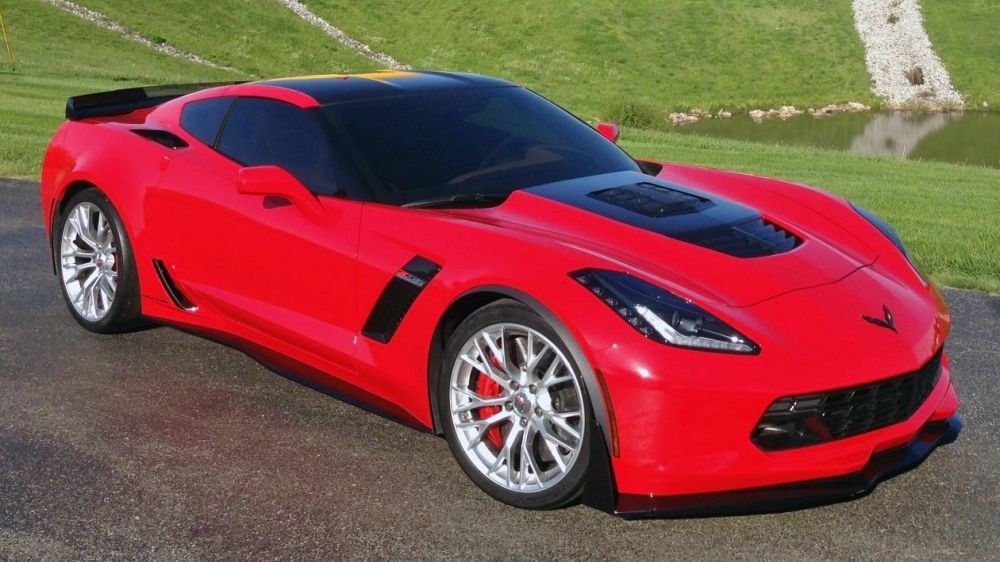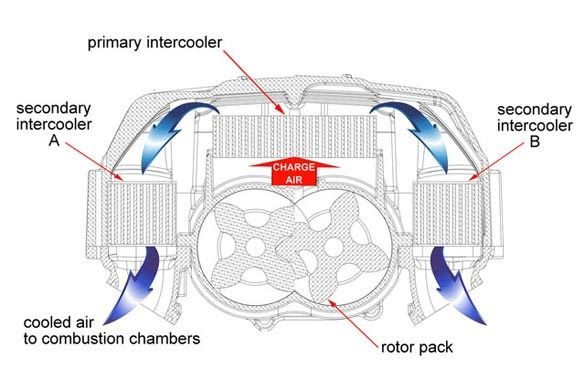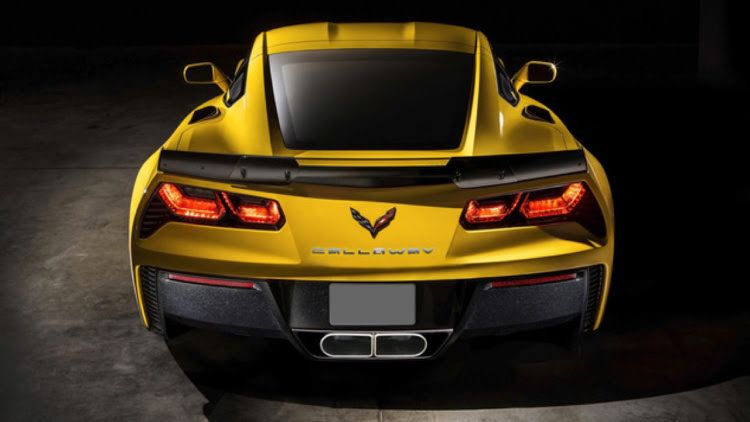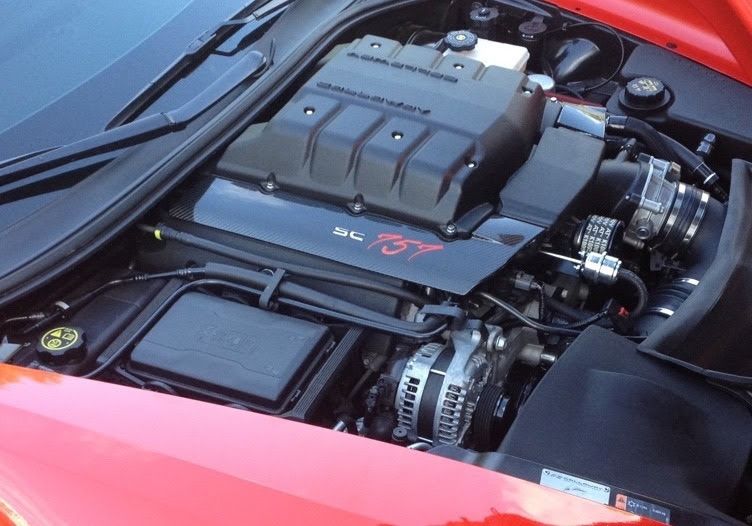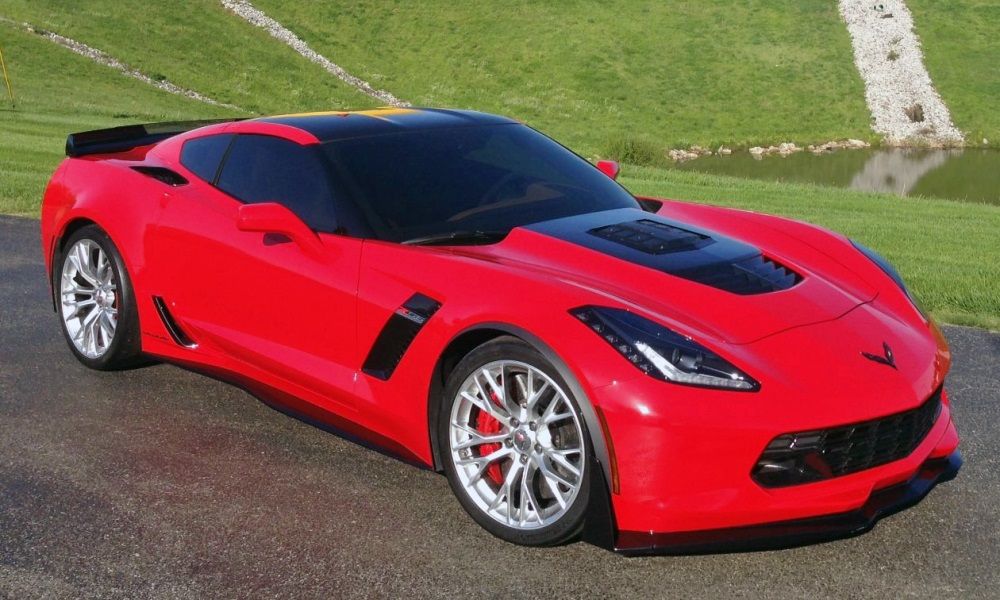Tuner and performance parts manufacturer Callaway Cars->ke19 has revealed details on its flagship 2015 Chevrolet Corvette Z06 package, and it promises over 750 horsepower, an innovative new supercharger design, and even a factory-quality warranty.
Boasting widespread dealership support, Callaway sees itself less as an aftermarket-accessory maker and more of a one-stop high-performance provider. Originally founded in 1977, Callaway Cars has a long list of successful products, with both road-going sports cars->ke506 and track-only racers->ke148 on its resume. Just a few examples include the Sledgehammer Corvette, a twin-turbo kit for the Alfa Romeo->ke1386 GTV-6, a turbo kit for the Mazda->ke53 Protégé and the race-winning 2014 Chevrolet Corvette Z06.R GT3.
The company provides engineering and manufacturing services, car design and development, carbon-fiber manufacturing and competition-ready vehicle solutions, which should mean any performance package it offers is top-shelf.
Such is the case with this C7 Z06 upgrade. But with so many outrageously overpowered muscle cars->ke507 prowling the streets these days, what makes this one special?
Continue reading to learn more about the Chevrolet Corvette Z06 By Callaway Cars.
2016 Chevrolet Corvette Z06 By Callaway Cars
- Make: Array
- Model: 2016 Chevrolet Corvette Z06 By Callaway Cars
- Engine/Motor: V8
- Horsepower: 757 @ 6200
- Torque: 777 @ 4500
- [do not use] Vehicle Model: Array
Exterior
Even in 100 percent factory-stock form, the C7 Z06 looks like a hotrod spaceship from beyond the moon. It’s two parts sci-fi, one part bodybuilder, three parts GT car, and 10 parts head-turning bad-assery. Suffice to say, subtlety is not its strong suit.
Callaway actually manages to up the ante with a few bits and pieces that add to the original formula. It’s not much, and it’s quite possible that only true ‘Vette lovers will notice the difference from a distance, but get up close and things become more obvious.
The most prominent change is in the pointed, shark-like frontend, where a unique Callaway supercharger surround trim ring sits atop the bulging, louvered hood. It’s like an extra ridge of muscle developed by hitting the gym for an additional 15 minutes a day.
Pop the hood, and you’ll find Callaway carbon-fiber engine mid-covers adorning the new blower surround. These add a bit of spice to the sizable engine bay, and fit well with the theme of over-the-top performance showmanship. Boldly inscribed on these composite covers is “SC 757.” You can probably guess what that stands for.
Less conspicuous is the Callaway underhood build plaque inscribed with the vehicle identification number, a nice little extra that adds to the package’s overall sense of authenticity and quality.
Further indications of the car’s character come with Callaway badging (“No, they did not misspell ‘Corvette’”). For options, customers can plunk down $540 for a custom-fit indoor Corvette->ke1280 car cover with an elastic hem, soft-flannel material and an embroidered Callaway logo.
Interior
Like the exterior, Callaway saw fit to add only minor details to the Z06’s interior. Standard equipment includes floor mats embroidered with Callaway branding, doorsills hewn from anodized aluminum (also stamped with Callaway branding), and the odd Callaway badge just in case you didn’t get the memo.
Other bits include Callaway key fobs and a Callaway plaque mounted to the center console for even further indication of authenticity.
Minor details, but no big deal – I doubt anyone looking into Callaway would really care too much about upgrading the upholstery or infotainment system beyond what’s already offered. As is, the Z06’s cabin is nicely outfitted and has a driver-centric layout perfectly suited to the high-end performance car segment. So why mess with it?
Drivetrain
I’m expecting most of you skipped directly to this section of the review, so I’ll get the important information out of the way first: the Callaway Corvette Z06 produces 757 horsepower at 6,200 rpm and a lucky 777 pound-feet of torque at 4,500 rpm, which is a sizable jump from the stock vehicle’s 650 horsepower at 6,400 rpm and 650 pound-feet of torque at 3,600 rpm.
Callaway claims acceleration figures now look like 2.8 seconds to 60 mph from a standstill (3.0 seconds stock), with a quarter-mile pass done in 10.5 seconds at 131 mph (from 11.2 seconds at 127 mph).
How’d they do it? In true American muscle car form, Callaway poses the following question on its website: “Why go big, when you can go bigger? Size matters.” It’s hard to argue with logic like that, just like it’s hard to argue with an extra 107 horsepower, 127 pound-feet of torque, and a fat, juicy dyno curve.
Internally, the V-8 is stock, still displacing 6.2-liters. However, the old blower was tossed in favor of a new unit developed in-house by Callaway. Output from a positive displacement supercharger is proportional to its size, thus the Callaway Z06 gets a supercharger that’s 32 percent larger than the stocker, up to 2,300 cc over the old unit’s 1,740 cc.
It’s called the Callaway GenThree supercharger, and clearly, the tuner spent a lot of time creating it. In addition to higher output, Callaway’s design helps to eliminate heat soak and the consequent power loss.
The supercharger housing and integrated intake manifold work to reduce the charge air temperature through clever design work. On the older-generation blower, charge air exits the supercharger and runs through a single liquid-to-air intercooler, then heads into a log-style manifold without runners leading to the cylinder head ports. Callaway says that the system worked, but left room for improvement.
The ThirdGen system rotates the rotor pack assembly 180 degrees so that the charge air is directed upwards towards the top of the housing and through a primary intercooler, then around the side of the housing. The intercooler transfers heat from the charge air to the intercooler coolant, which is then circulated through a heat exchanger in front of the radiator, dissipating waste heat into the atmosphere.
The chilled charge air then exits the intercooler and flows through the top portion of the supercharger housing, which is exposed to ambient air, further lowering the temperature. Finally, before it reaches the cylinder heads, the air goes through two auxiliary sets of intercoolers, one per cylinder bank, rendering a “triple-element” cooling design.
This allowed Callaway’s engineers to use low-restriction intercoolers and minimize charge air pressure reduction. According to the tuner, the result of all this work is a mere 10-degree Fahrenheit increase in inlet air temperatures during dyno pulls, compared to the 35-degree Fahrenheit temperature increase with other supercharger systems. And in case you were unaware, less heat soak makes for more consistent performance.
The utility and design aspects of the GenThree supercharger are so unique, the U.S. Patent and Trademark Office has awarded the system a patent pending status.
Callaway also redesigned the manifold to maintain consistent charge air temperatures, low restriction and even airflow distribution across all cylinders. The result is a broad torque band with over 500 pound-feet available from as low as 2,000 rpm, which yields more consistent power delivery and improved driving characteristics in any performance-driving environment.
Making the boost is Eaton’s TVS rotor pack, which was selected for its high levels of thermal efficiency, OEM-certified quality, and proven reliability. The new unit also uses a 10-rib drive pulley system, eliminating the earlier design’s jackshaft, preventing slippage.
Supporting the innovative new blower is a Callaway high-flow intake system, which uses an internal bypass that diverts the inlet-air flow path during idle, low-load cruising and deceleration, allowing the supercharger internals to spin freely, thus reducing parasitic drag on the driveline. Consequently, Callaway claims fuel mileage is “practically unchanged from stock fuel mileage” (the stock figures are 23-mpg highway and 13-mpg city when equipped with the eight-speed automatic transmission).
And as anyone with a modified car will tell you, emissions compliance is critical. The Callaway Z06 will pass smog in all 50 states.
Customers also get a few available options, including a short-throw shifter for the seven-speed manual transmission, and a custom sport exhaust with a unitized acoustic chamber and well-endowed “Double-D” tips that replace the four stock pipes.
As for the rest of it, Callaway left the suspension and brakes untouched, which is fine considering factory stock includes 14-inch rotors, six-piston calipers, an electronic limited-slip differential and enough tire to pull well over 1 G on the skidpad.
Drivetrain Specifications
|
Engine |
Supercharged, 6.2-liter V-8 |
|
Horsepower (HP @ RPM) |
757 @ 6,200 |
|
Torque (LB-FT @ RPM) |
777 @ 4,500 |
|
Acceleration (0-60 MPH) |
2.8 sec. |
|
Quarter mile |
10.5 seconds at 131 mph |
Prices
To get the Callaway Corvette Z06 package, prepare to shell out $16,995. Added to the MSRP of a base Z06 ($79,000), and you’re looking at a figure just under $100,000.
That’s a lot, even for a rocket ship ‘Vette like this one. However, for the money, you do get quite a bit of premium support, especially from an aftermarket tuner special.
Included as standard is a Callaway Authenticity Documentation Package and a 3-year/36,000-mile limited warranty. The warranty actually overlaps with factory GM->ke1024 warranties, covering all Callaway components and GM components that are affected by Callaway components. That means you can get your Callaway-equipped Corvette serviced at any nationwide GM dealership. Impressively, Callaway offers this warranty as standard for every car and truck it tunes.
For an extra $2,900, customers can get the optional 5-year/60,000-mile Extended Powertrain Service Contract, which also matches the factory GM warranty.
After leaving Chevy’s->ke199 factory in Bowling Green, Kentucky, each Corvette destined for Callaway-ization is delivered for final assembly to one of two tuner plants in Old Lyme, Connecticut or Santa Ana, California. Delivery can be arranged at either a local Chevy dealer or Callaway facility. If you’re a real bowtie fanatic, you could also opt to pick yours up at the National Corvette Museum in Kentucky.
Call Callaway Cars at 860-434-9002 with questions or to schedule a test drive.
Competition
Hennessey Performance HPE750 C7 Z06
If you’re gonna talk about fast cars going faster, you gotta at least mention Hennessey Performance.->ke1863 This Texas-based tuner is probably best known for creating the 2011 Hennessey Venom GT, aka the 270-mph uber-Exige->ke525 that set a new Guinness World Record for fastest production car back in 2013. Hennessey also does ‘Vettes, and offers several upgrade levels for the new Z06, starting with the HPE750. As you could probably guess, total output for this one comes to 750 horsepower at 6,300 rpm, with the parts list including a new pulley upgrade, a high-flow intake and stainless-steel headers, plus some exterior badging and new interior floor mats. There’s also a 3-year/36,000-mile limited warranty.
Read our full review of the Hennessey-tuned Corvette Stingray here.
2015 Dodge Challenger SRT Hellcat
What’s that you say? More than 700 horsepower? Dodge->ke28 does that, and from the factory too. For less money than a base model Z06, you can get 707 horsepower and 650 pound-feet of torque from a supercharged 6.2-liter Hemi V-8 with a bit of car wrapped around it. While huge demand made it difficult to actually get one when it was first released, Dodge is currently doubling production and streamlining the order process, which means you should be able to get a 2016 Hellcat without too much hassle. While not quite as fast or rare as the Callaway Z06, this bruiser still offers unparalleled bang for your muscle-car buck.
Read our full review here.
Conclusion
Callaway Cars gets it. I know this for a variety of reasons, not the least of which is the list of launch tips on the company’s website FAQ (start at 1,500 rpm and try not to overpower the tires, shifting to second before 6,400 rpm. Aim for a 1.6-second 60-foot time). Throw in the fact that the company has been around since the ‘70s, has proven competition experience, and has even applied for a patent for its in-house supercharger design, and it’s clear this package has the credentials to back it.
What’s more, the company’s founder, Reeves Callaway, was a racing driver, going from SCCA Formula Vee to driving instruction at the Bob Bondurant racing school, finally ending up in his garage making turbo kits.
The company clearly prides itself on an obsessive attention to detail and superior craftsmanship, which is clear looking at the design of the supercharger used on this package.
But a few problems creep up when you stand back to assess the environment Callaway plays in. First is the price. At $100,000, a plethora of alternatives are available, both from the factory and aftermarket, and it’s hard to not consider something else that might offer more refined driving characteristics and a bit more comfort. Even output bragging rights might be in contention when you consider how something like a Hellcat would offer a lot more financial wiggle room to explore the limits of the aftermarket (albeit most likely without a warranty).
Also, Callaway really only touched the engine with this one, with the exterior, interior and handling all going unaltered. Again, that’s ok given the superb features the Z06 offers in these areas in stock spec, but for buyers looking for something more track focused, this package may leave them wanting.
That said, I think this is a very solid package for anyone looking to smash their neighbor’s ‘Vette at the strip, and when it comes to aftermarket performance, Callaway is undoubtedly one of the best.

